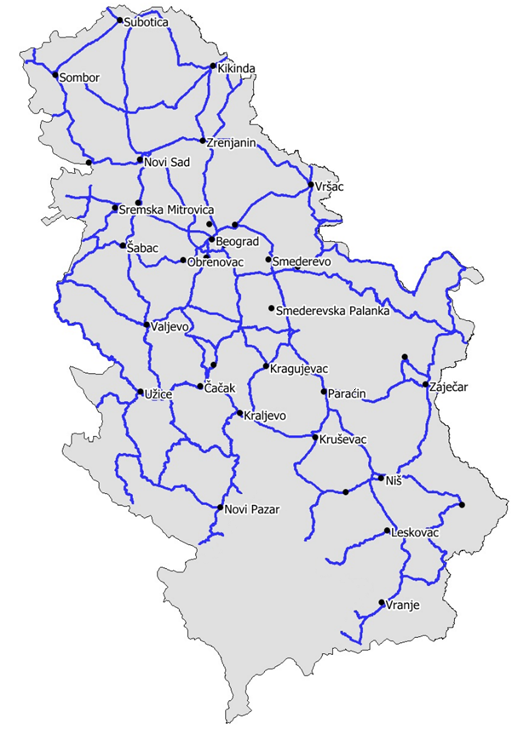 Detailed Information
Detailed Information The campaign covered 35 cities and 10,000 km of Serbian roads and was divided into three area type categories: Large Cities, Small Cities and Roads. The number of tests samples collected during drive tests (in each network over 6000 voice calls and around 3500 of every data service tests were done) allows to receive accuracy better than 3% for standard error with confidence level better than 95%.
Drive test routes that were measured, are presented in Figure 1.

Fig. 1. Drive test routes
Measurements were performed in a drive test mode, which means that the measurement equipment was installed in moving vehicles. Measurement equipment collects network data by running voice and data tests and using a scanner to obtain radio network parameters. All three mobile networks were measured at the same time and on the same drive test routes using the same smartphones - Samsung Galaxy S4 for voice tests and Samsung Galaxy Note 4 for data tests. The Samsung Galaxy Note 4 is a Cat. 6 mobile device, which means that it supports 4G (LTE) data speeds up to 300 Mbps for data receiving and 50 Mbps for data sending. All smartphones worked in automatic technology selection mode. To reflect the latest technical developments in the mobile networks and to examine the benefits from available capabilities, SIM cards with the most comprehensive mobile tariff plans (tariff plans with the highest data rates, highest number of minutes, largest amount of data volume) available from each operator were used.
Mobile Tariff plans used for testing networks are shown in Table 1:
| Operator | Tariff plan used for voice tests | Tariff plan used for data tests |
|---|---|---|
| Telekom Srbija | BIZNET 300 (200 MB) | BIZNET 300 (30 GB) |
| Telenor | PREMIUM+ | SURF+50 |
| Vip mobile | NEO10 | Vip Online 48 |
Table 1. Mobile Tariff plans
The measurement system consisted of two test cars equipped with identical measurement equipment (SwissQual Diversity Benchmarker II) capable of measuring all network technologies and services simultaneously to a very high accuracy. In order to perform voice tests, the Samsung Galaxy S4 smartphones permanently called each other, within the same mobile network. In Large Cities, voice tests were executed in mobile to mobile scenario between two cars, in Small Cities and on the Roads mobile to mobile calls were performed within the same car. The aforementioned specific setup in Large Cities allowed for effective data collection without performing too much voice traffic within the single radio cell in areas where higher mobile traffic is expected. Voice tests assess network accessibility, retainability and quality of speech. Voice calls with 85 seconds call duration were measured during benchmarking.
Test equipment installed in cars is presented in Figure 2.




Fig. 2. Test Equipment installed in cars
The receiving or sending of additional data during the voice test call was added to the measurement scenario in order to simulate behaviour of a regular subscriber using a smartphone device, for which background data transmissions are typical during the voice call. For each of the voice calls, the quality of speech samples was measured (MOS – Mean Opinion Score) using the standard POLQA P.863 algorithm.
Data tests were performed using Samsung Galaxy Note 4 smartphones and a dedicated measurement server located at the Serbian Open eXchange (SoX) in Belgrade, which ensured a fair transmission path to all three mobile networks. Data tests assess the network availability, stability, typical performance and highest capabilities. The most representative data services measured during benchmarking were:
To simulate the behaviour of average mobile subscriber in Serbia surfing the Internet, a set of websites was tested, based on their popularity amongst Serbian users:
https://www.google.rs
https://www.facebook.com
https://m.kupujemprodajem.com
https://www.kupindo.com
In the YouTube test, the quality of a live stream was measured (VMOS - Video Mean Opinion Score) using the standard J.343.1 algorithm.
A scanner (PCtel MX) was used to test radio parameters of the mobile networks. SwissQual NQDI software was used for network data post-processing and reporting. The post-processing activity was supported by the use of the Systemics-PAB proprietary Data Warehouse for a customized analysis.